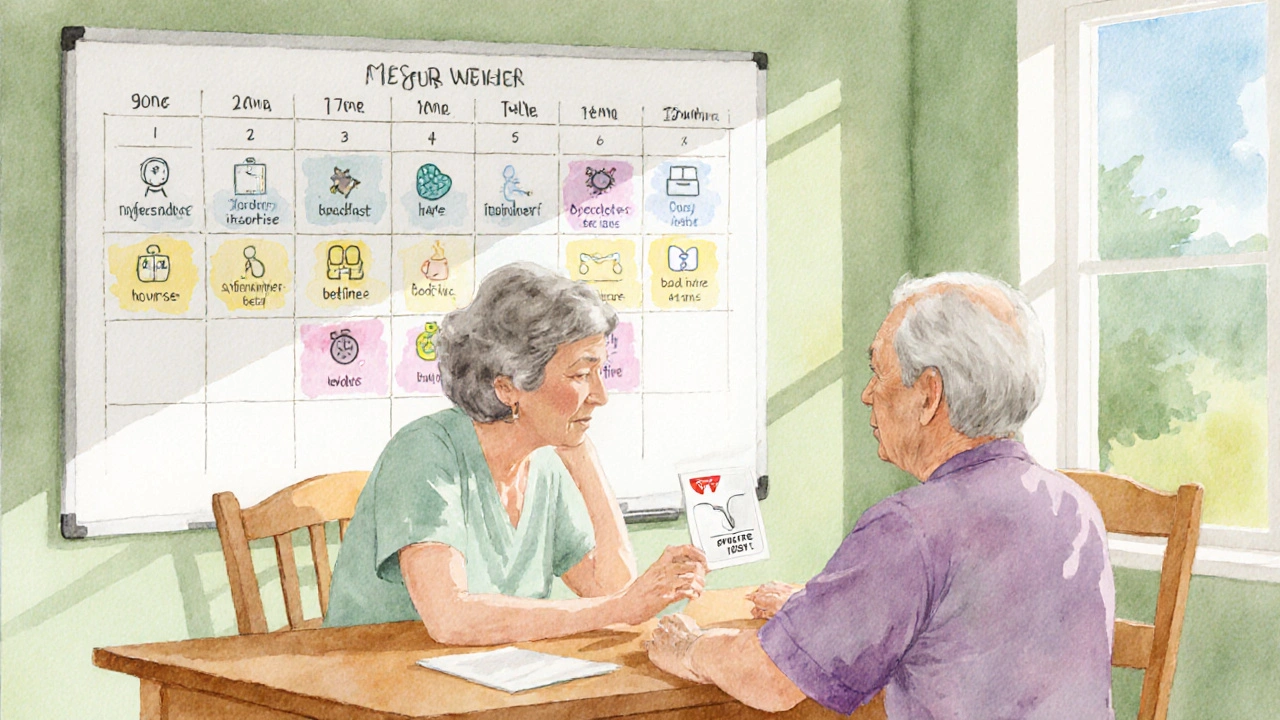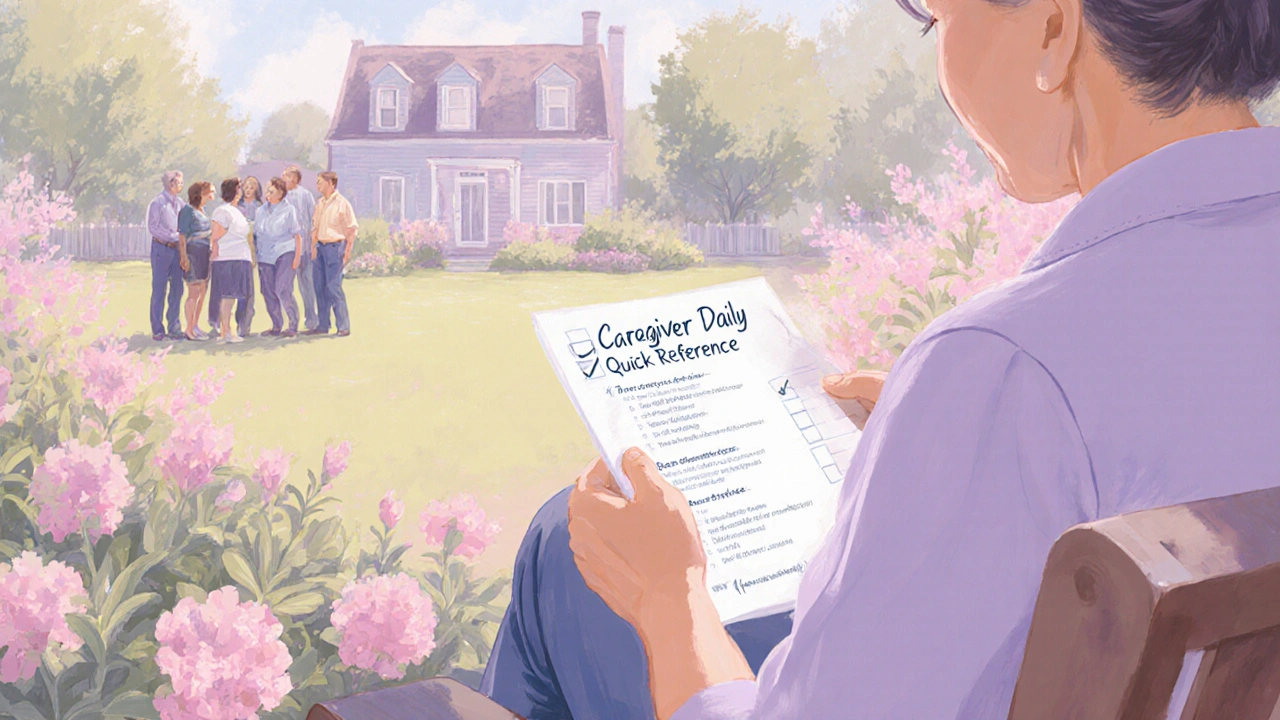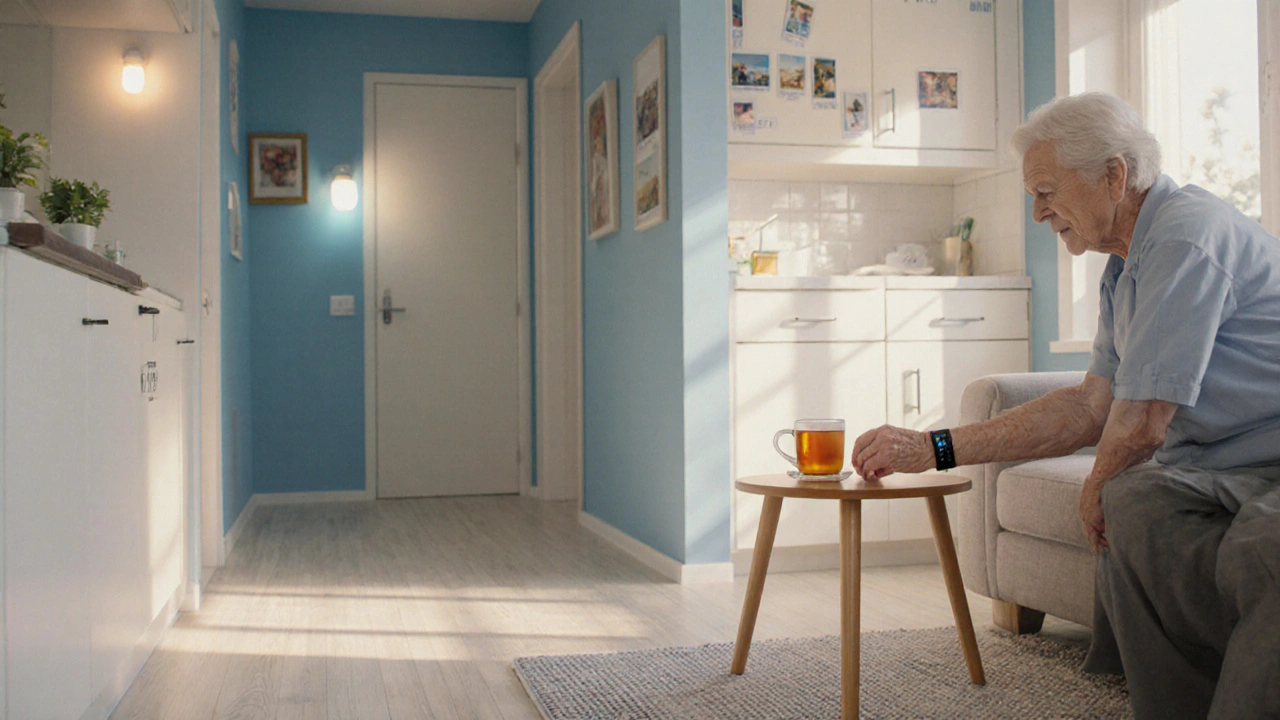Alzheimer Care Stage Guide
Select a stage to learn about its characteristics and recommended care approaches:
Early Stage
Mild symptoms, memory lapses, minor confusion
Middle Stage
Noticeable personality changes, wandering, hygiene issues
Late Stage
Complete dependence, loss of communication, motor skills
Stage Overview
Select a stage above to view detailed information and care recommendations.
Safety Tips for Each Stage
- Early Stage: Install night-lights and secure loose rugs
- Middle Stage: Use lockable cabinets for medications and sharp objects
- Late Stage: Remove tripping hazards and install bed rails
Communication Strategies
- Use short, simple sentences
- Speak slowly and clearly
- Validate emotions and feelings
- Use visual cues and gestures
Daily Care Checklist
- ✓ Morning: check vitals, medication, hygiene
- ✓ Breakfast: balanced protein-rich meal, hydrate
- ✓ Mid-morning: safety walk, environment scan
- ✓ Lunch: simple food, evaluate mood
- ✓ Afternoon: cognitive activity, light exercise
- ✓ Evening: dinner, wind-down routine, medication
- ✓ Night: lock doors, set alarm, final safety check
Key Takeaways
- Set up a safe, predictable environment before the disease progresses.
- Use simple, compassionate communication to reduce frustration.
- Develop a flexible care plan that includes medication, nutrition, and activity.
- Lean on support groups, respite services, and legal guidance to avoid burnout.
- Check off the daily caregiver checklist to stay organized and focused.
When a family member is diagnosed with Alzheimer-type dementiaa progressive brain disorder that slowly erodes memory, reasoning and behavior, the responsibility often falls to a caregiverthe person who provides daily assistance, emotional support and supervision. This guide walks you through the essential steps, from making the home safer to handling the toughest mood swings, all while keeping your own wellbeing in mind. The goal isn’t to turn you into a medical professional - it’s to give you Alzheimer care tools you can apply right away.
Understanding Alzheimer-type Dementia
Alzheimer-type dementia is the most common form of dementia, accounting for roughly 60‑70% of cases worldwide. It starts with subtle forgetfulness and escalates to severe impairment of language, spatial awareness, and daily functioning. The disease typically follows three stages:
- Early stage: occasional word‑finding trouble, misplacing items, and mild confusion.
- Middle stage: noticeable personality shifts, wandering, and difficulty with personal hygiene.
- Late stage: total dependence, loss of basic motor skills, and inability to communicate.
Knowing the stage helps you match care strategies to the person’s current abilities. It also informs when to bring in professional aides or consider advanced‑care planning.
Creating a Safe Home Environment
Safety is the foundation of any care plana structured set of actions that address health, safety, and quality‑of‑life goals for the person with dementia. Simple modifications can prevent falls, reduce wandering, and keep hazards out of reach.
- Install night‑lights in hallways and bathrooms to guide nocturnal trips.
- Secure rugs and cords; replace them with non‑slip flooring.
- Use lockable cabinets for medications, cleaning supplies, and knives.
- Label closets and drawers with pictures to aid orientation.
- Consider a GPS‑enabled wristband if wandering is a concern.
Make changes gradually. Sudden, large‑scale rearrangements can increase confusion, especially in the middle stage.

Structuring Daily Routines
People with Alzheimer-type dementia thrive on predictability. A daily schedule reduces anxiety and frees up mental bandwidth for enjoyable activities.
| Time | Activity | Why it Helps |
|---|---|---|
| 7:00am | Morning hygiene (brush teeth, wash face) | Establishes a familiar start |
| 8:00am | Breakfast with protein‑rich foods | Supports brain health |
| 10:00am | Light exercise (walk, chair yoga) | Improves mood and mobility |
| 12:00pm | Lunchtime - simple menu | Prevents overwhelm |
| 2:00pm | Memory‑stimulation activity (puzzle, music) | Keeps cognition engaged |
| 6:00pm | Dinner and quiet TV | Signals winding down |
| 9:00pm | Bedtime routine (reading, dim lights) | Promotes better sleep |
Write the schedule on a large whiteboard or fridge where everyone can see it. Adjust as needed-flexibility prevents frustration when the person is “off” on a particular day.
Effective Communication Strategies
Communication can feel like walking on a tightrope. The key is to be clear, calm, and compassionate.
- Use short, simple sentences. “Please take your medicine now.”
- Speak slowly and give extra time for responses. Pause after each question.
- Validate emotions. If they seem scared, say, “I understand you’re feeling uneasy; I’m here with you.”
- Use visual cues. Point to objects, use picture cards, or gesture.
- Stay patient. Avoid correcting repeatedly; redirect instead.
When frustration spikes, gently guide the conversation to a familiar topic-favorite music, a beloved photograph, or a cherished hobby.
Managing Behavioral and Psychological Symptoms
Behavioral changes like agitation, aggression, or wandering are common in the middle stage. They often signal unmet needs, such as pain, boredom, or overstimulation.
First, rule out medical causes (infection, pain, medication side‑effects). Then apply non‑pharmacological tactics:
- Redirection. Offer a soothing activity when agitation appears.
- Environment calming. Lower noise, dim lights, and remove clutter.
- Routine adherence. Stick to the schedule created earlier.
- Physical comfort. Check clothing, temperature, and toileting needs.
If these steps don’t help, consult the person’s doctor about possible medication adjustments, but remember drugs are a last resort due to side‑effects.
Medication Management and Health Monitoring
Many people with Alzheimer-type dementia take cholinesterase inhibitors (donepezil, rivastigmine) or memantine to slow cognitive decline. Consistency is crucial.
- Use a weekly pill organizer with labeled compartments.
- Set alarms on a phone or smart speaker for each dose.
- Keep a medication list with dosage, timing, and prescribing physician.
- Schedule regular check‑ups (every 3‑6months) to monitor effectiveness and side‑effects.
Track vital signs like blood pressure, weight, and glucose levels in a simple notebook or app. Early detection of health issues prevents crises.

Support Networks and Respite Options
Caregiving can be isolating. Building a support network protects both you and your loved one.
- Support groupsregular meetings-online or in‑person-where caregivers share experiences and coping strategies offer emotional relief and practical tips.
- Respite caretemporary short‑term care services that give family caregivers a break can be in‑home aides, adult‑day centers, or overnight facilities.
- Local Alzheimer’s Association chapters often provide counseling, educational workshops, and legal‑financial clinics.
- Ask friends or nearby relatives to rotate “care shifts”-even a few hours can recharge you.
Legal, Financial, and Ethical Planning
Early planning reduces future stress. The following documents should be addressed while the person can still participate:
- Power of Attorney (POA). Grants you authority over medical and financial decisions.
- Advance Directive. Records wishes about life‑sustaining treatments.
- Will and Estate Plan. Outlines asset distribution and guardianship.
Consult a elder‑law attorney to ensure documents comply with state regulations. Also, explore Medicaid or long‑term‑care insurance options before the disease progresses.
Caregiver Checklist - Your Daily Quick‑Reference
- Morning: check vitals, medication, hygiene.
- Breakfast: balanced protein‑rich meal, hydrate.
- Mid‑morning: safety walk, environment scan.
- Lunch: simple food, evaluate mood.
- Afternoon: cognitive activity, light exercise.
- Evening: dinner, wind‑down routine, medication.
- Night: lock doors, set alarm, final safety check.
Tick off each item on a paper pad or digital note‑taking app. The act of checking reduces forget‑fulness and gives a sense of accomplishment.
Frequently Asked Questions
How often should I change the caregiving routine?
Adjust the routine when you notice consistent resistance or when the person’s abilities shift. Small tweaks-like moving a favorite activity earlier-can keep the schedule flexible without causing confusion.
What are the safest ways to handle wandering?
First, secure doors and use locks that are easy for you but not for the person. Second, create a “safe room” with familiar items where they can rest if they become disoriented. Third, consider GPS trackers or a wander‑alert system attached to clothing.
When is it appropriate to use medication for behavioral symptoms?
Medication should be a last resort after exhausting environmental and behavioral strategies. Always discuss risks and benefits with a neurologist or geriatric psychiatrist, and monitor side‑effects closely.
How can I take care of my own mental health while caregiving?
Schedule regular breaks-use respite care, ask friends for help, or trade shifts with another family member. Stay active, maintain hobbies, and consider counseling or support‑group attendance to process emotions.
What nutritional guidelines help slow cognitive decline?
A Mediterranean‑style diet-rich in fruits, vegetables, whole grains, fish, olive oil, and limited red meat-has been linked to slower progression. Hydration is equally important; aim for at least 6‑8 cups of water daily.
Providing care for someone with Alzheimer-type dementia is a marathon, not a sprint. By building a safe environment, establishing consistent routines, communicating gently, and leaning on professional and community resources, you give your loved one dignity and you protect your own health. Keep this guide handy, revisit the checklist each day, and remember that asking for help is a sign of strength, not weakness.


Comments (5)
Hey folks, thanks for sharing this massive guide – it’s like a lifeline for anyone thrust into caregiving. I love how you broke down the stages and gave quick‑checklists; it makes the day‑to‑day feel less chaotic. Remember to sprinkle in short “wins” for yourself, even a 5‑minute tea break can reset your patience. Also, using picture labels on drawers is a game‑changer for orientation, especially in the middle stage. Keep the tone gentle, and don’t forget to celebrate tiny moments of connection. You’ve got this!
It must be noted, however, that the guide overly romanticizes the caregiver’s role while neglecting the systemic failures of our healthcare infrastructure. The suggestion to “lean on support groups” trivially addresses a problem that requires policy reform, not individual resilience. Moreover, the emphasis on medication adherence sidesteps the ethical debate surrounding off‑label prescriptions in dementia care. A more critical appraisal of institutional responsibilities would provide a balanced perspective.
In defintely every guideline posted there are hidden agendas; pharma companies push pills while they hide their true motives. The guide pretends to be neutral but it’s actually a marketing tool designed to keep patients on a never‑ending cycle of meds. You should also consider who funds this information – the answer might surprise you. Also, safety measures like lockable cabinets are just a way to control rather than empower the patient. Think beyond the surface.
Interesting points, especially the caution about over‑reliance on pharmaceuticals. While the guide does stress medication consistency, it also highlights non‑pharmacological interventions like music therapy and gentle exercise, which can be quite effective. Balancing both approaches tends to yield better outcomes than putting all hopes in one direction. It’s also worth noting that caregiver stress can influence how we perceive the recommendations, so stepping back and reviewing the evidence helps maintain perspective.
First, the checklist is exemplary; second, the layout is clear; third, the language is precise; however, one must still verify each recommendation against local regulations; moreover, the safety tips align with OSHA standards; finally, the communication strategies adhere to best‑practice guidelines; ensure that each bullet point is cross‑referenced with a peer‑reviewed source; otherwise, the advice may be considered anecdotal.